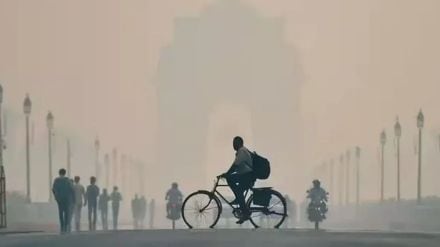Delhi’s air quality has once again dropped to dangerous levels. On Sunday morning, a thick layer of smog covered the city as the Air Quality Index (AQI) touched 391, putting it in the ‘severe’ category. An AQI between 301 and 400 is considered very poor and can cause breathing problems on long exposure. Levels above 400 fall in the severe range and can harm even healthy people, especially those who spend time outdoors.
Many people believe that fitness protects them from such pollution, but doctors say that even athletes and those who are healthy or physically fit can feel breathless when air quality becomes this bad.
Why do fit people also struggle to breathe?
“Even healthy lungs cannot handle air this polluted,” explains Dr. Vijay Kumar Agrawal, Director of ICU and Pulmonology at Yatharth Super Speciality Hospital, Faridabad. “When AQI levels go above 400, the air is filled with tiny pollutants like PM2.5, nitrogen oxides, ozone, and carbon monoxide. These particles irritate the airways and make breathing harder.”
During exercise, the breathing rate increases, which means more polluted air enters the lungs. The fine particles travel deep into the lungs and cause inflammation and narrowing of airways, leading to tightness in the chest and shortness of breath.
How pollution affects the body during exercise
“Carbon monoxide from vehicles binds to haemoglobin in the blood and reduces the oxygen available to muscles,” says Dr. Agrawal. “That’s why even fit people feel tired faster and can’t perform as well.”
Other pollutants like ozone and nitrogen dioxide also damage blood vessels, reducing the body’s ability to carry oxygen. The result is a drop in stamina and endurance, even among healthy individuals.
Polluted air also creates oxidative stress, which can damage lung tissues over time and make them more sensitive to allergens and infections. “If you’re exposed to this air for too long, your lungs start losing their capacity,” adds Dr. Agrawal.
Should you exercise outdoors when AQI is poor?
Experts strongly advise against outdoor workouts when AQI levels are in the very poor or severe range. “Even a short morning jog can trigger coughing or wheezing,” says Dr. Agrawal. He suggests exercising indoors when pollution levels are high and using an air purifier if possible.
It’s also important to drink plenty of water to help the body flush out toxins and avoid peak traffic hours when pollution is at its worst. For those who must step outside, wearing an N95 mask can provide some protection, although it may make breathing harder during intense workouts. Dr. Agrawal also advises seeing a doctor if you experience constant breathlessness, coughing, or chest tightness.
Protect your lungs during smog season
“Fitness is not just about physical strength, it’s about protecting your health,” says Dr. Agrawal. “Poor air quality can harm everyone, no matter how fit they are. It’s better to stay cautious and avoid pushing your body too hard when the air is bad.”
Experts believe long-term solutions like improving public transport, reducing vehicle emissions, and planting more trees are crucial to control pollution. But for now, awareness and prevention are the best ways to stay safe.
